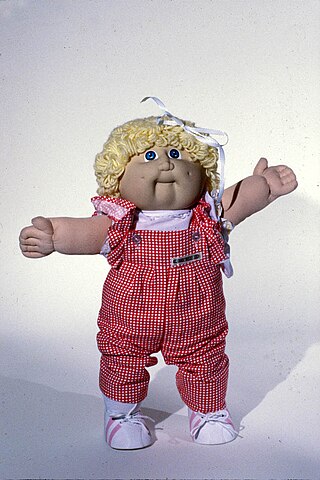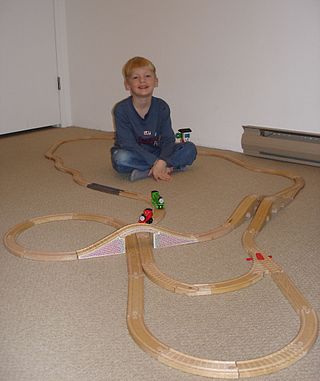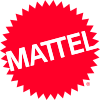
Cabbage Patch Kids are a line of cloth dolls with plastic heads first produced by Coleco Industries in 1982. They were inspired by the Little People soft sculptured dolls sold by Xavier Roberts as collectibles. The brand was renamed 'Cabbage Patch Kids' by Roger L. Schlaifer when he acquired the exclusive worldwide licensing rights in 1982.

Injection moulding is a manufacturing process for producing parts by injecting molten material into a mould, or mold. Injection moulding can be performed with a host of materials mainly including metals, glasses, elastomers, confections, and most commonly thermoplastic and thermosetting polymers. Material for the part is fed into a heated barrel, mixed, and injected into a mould cavity, where it cools and hardens to the configuration of the cavity. After a product is designed, usually by an industrial designer or an engineer, moulds are made by a mould-maker from metal, usually either steel or aluminium, and precision-machined to form the features of the desired part. Injection moulding is widely used for manufacturing a variety of parts, from the smallest components to entire body panels of cars. Advances in 3D printing technology, using photopolymers that do not melt during the injection moulding of some lower-temperature thermoplastics, can be used for some simple injection moulds.
Kenner Products, known simply as Kenner, was an American toy company founded in 1946. Throughout its history, the Kenner brand produced several highly recognizable toys and merchandise lines including action figures like the original series of Star Wars, Jurassic Park and Batman as well as die cast models. The company was closed and merged by its corporate parent Hasbro in 2000.
Boglins were a series of toy puppets distributed by Mattel. They were created by Tim Clarke, Maureen Trotto, and Larry Mass, and licensed by Seven Towns. The original run of Boglins was released in 1987, coinciding with a "creatures" craze that included Ghoulies, Critters, and Gremlins. Boglins were goblin-themed hand puppets made of flexible rubber and could be manipulated to represent speech and facial expressions. Several series of large and small Boglins were released until 1994, with additional aquatic, Halloween, and baby themed Boglins released later into the line. Small solid 'Mini-Boglins' were also produced, akin to the Kinkeshi figures also from the 1980s.
Thermoforming is a manufacturing process where a plastic sheet is heated to a pliable forming temperature, formed to a specific shape in a mold, and trimmed to create a usable product. The sheet, or "film" when referring to thinner gauges and certain material types, is heated in an oven to a high-enough temperature that permits it to be stretched into or onto a mold and cooled to a finished shape. Its simplified version is vacuum forming.

Jakks Pacific, Inc. is an American company that designs and markets toys and consumer products, with a range of products that feature numerous children's toy licenses. The company is named after its founder, Jack Friedman, who had previously founded LJN and THQ and presided over the company until retiring as CEO and chairman after March 31, 2010, a month before his death on May 3, 2010.
Major Matt Mason was an action figure created by Mattel. He was an astronaut who lived and worked on the Moon. When introduced in 1966, the figures were initially based on design information found in Life Magazine, Air Force Magazine, Jane's, and other aviation- and space-interest periodicals. Later, the line attempted to transition into the realm of science fiction.
A celebrity doll is a doll modeled after a celebrity.

Rotational molding involves a heated mold which is filled with a charge or shot weight of the material. It is then slowly rotated, causing the softened material to disperse and stick to the walls of the mold forming a hollow part. In order to form an even thickness throughout the part, the mold rotates at all times during the heating phase, and then continues to rotate during the cooling phase to avoid sagging or deformation. The process was applied to plastics in the 1950s but in the early years was little used because it was a slow process restricted to a small number of plastics. Over time, improvements in process control and developments with plastic powders have resulted in increased use.

Batman action figures have been produced since the 1940s. These action figures, inspired by the character's appearance in comics and serials, were created by DC Comics and manufactured by various toy companies. These figures were made of various materials such as wood, tin, and plastic. They were typically between 6 and 8 inches in height and featured movable joints that allowed them to be posed in various positions.
The Strange Change Machine was a Mattel toy introduced in 1968, in which "shape memory" plastic figures of prehistoric animals and science fiction-like creatures could be reconstituted from compressed "time capsule" form, and re-compressed back into that form. The label on the box read, "A Strange Change Toy featuring The Lost World," suggesting that perhaps this was the first of a proposed series. The "Lost World" was the only scenario produced with this toy before it was discontinued due to safety concerns.

Merchandise for the Thomas & Friends franchise has been produced to capitalize on the success of the television series Thomas & Friends. Whilst merchandise was produced alongside due to the popularity of the first of The Railway Series by the Rev. W. Awdry since 1945, and the original broadcast of the television series in 1984 in the United Kingdom, large numbers of manufacturers have sought to produce Thomas-branded items after the television series was broadcast in the United States and Japan.
Creepy Crawlers is an animated television series from 1994, produced by Saban Entertainment, that aired in syndication in the United States.
Elliot Handler was an American inventor, businessman, and the co-founder of Mattel. With his wife, Ruth Handler, he developed some of the biggest-selling toys in American history, including Barbie, Chatty Cathy, Creepy Crawlers, and Hot Wheels.

A plastisol is a colloidal dispension of small polymer particles, usually polyvinyl chloride (PVC), in a liquid plasticizer. When heated to around 180 °C (356 °F), the plastic particles absorb the plasticizer, causing them to swell and fuse together forming a viscous gel. Once this is cooled to below 60 °C (140 °F) it becomes a flexible, permanently plasticized solid product. This process is called 'curing'.
The Vac-u-form, was a toy invented by Eddy Goldfarb and released by Mattel in the 1960s around 1961 with the trademark filed on October 8, 1962.
WWE action figures are poseable action figures based on wrestlers and personalities of WWE. They are currently manufactured by Mattel and have formerly been manufactured by LJN, Jakks Pacific and Hasbro.

Jack Friedman was an American entrepreneur, businessman, veteran of the toy and video game industries, and a philanthropist. Regarded as an influential member in the toy and video game industries, Friedman founded the three toy companies LJN, THQ, and Jakks Pacific; LJN and THQ later switched focus to video games.
Toys-to-life is a video game feature using physical figurines or action figures to interact within the game. These toys use a near field communication (NFC), radio frequency identification (RFID), or image recognition data protocol to determine the individual figurine's proximity, and save a player's progress data to a storage medium located within that piece. It was one of the most lucrative branches of the video game industry especially during the late 1990s and 2010s, with the Skylanders franchise alone selling more than $3 billion worth over the course of four years.









